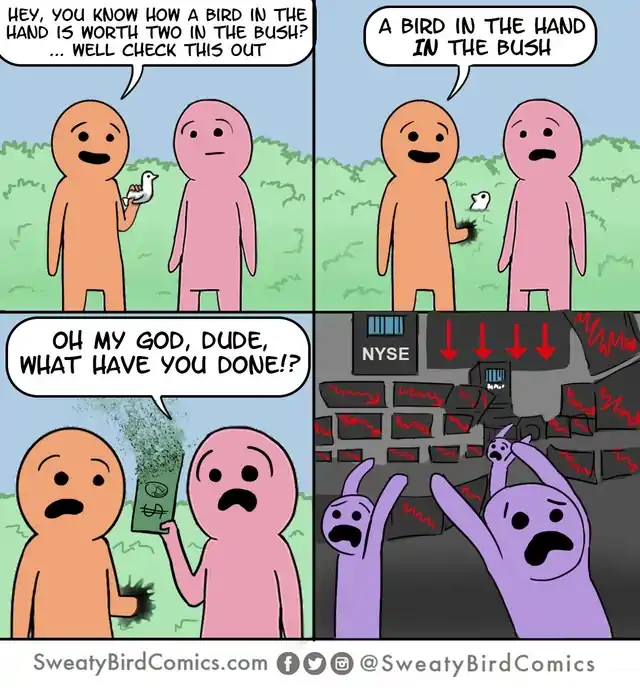Trading securities, hedging and portfolio design, practical
Shares, cryptocurrency, options and derivatives for babies
May 9, 2017 — January 13, 2025
Suspiciously similar content
Nothing to see here at the moment, apart from snippets I found interesting, as a guy with passable probability theory but weak financial knowledge.
1 Fundamental considerations
2 Behavioural considerations
3 Portfolio design
Diversity and risk hedging.
Bookmarked: Amazing science communication by Jonas Degrave, But why is diversification a free lunch?.
The R package introduction Fast Design of Risk Parity Portfolios by Zé Vinícius and Daniel Palomar is an interesting dummy’s guide to “Modern portfolio” and “risk-parity portfolio” theory.
In 1952, Markowitz proposed in his seminal paper [1] to find a trade-off between the portfolio expected return and its risk measured by the variance:
\[\begin{array}{ll} \underset{\mathbf{w}}{\textsf{maximize}} & \mathbf{w}^{T}\boldsymbol{\mu}-\lambda\mathbf{w}^{T}\boldsymbol{\Sigma}\mathbf{w}\\ \textsf{subject to} & \mathbf{w} \ge \mathbf{0}, \quad\mathbf{1}^T\mathbf{w}=1, \end{array}\]
where \(\lambda\) is a parameter that controls how risk-averse the investor is.
Markowitz’s portfolio has been heavily criticised for over half a century and has never been fully embraced by practitioners, among many reasons because:
- it only considers the risk of the portfolio as a whole and ignores the risk diversification (i.e., concentrates too much risk in few assets, which was observed in the 2008 financial crisis)
- it is highly sensitive to the estimation errors in the parameters (i.e., small estimation errors in the parameters may change the designed portfolio drastically).
Although portfolio management did not change much during the 40 years after the seminal works of Markowitz and Sharpe, the development of risk budgeting techniques marked an important milestone in deepening the relationship between risk and asset management.…
The alternative risk parity portfolio design has been receiving significant attention from both the theoretical and practical sides because it
- diversifies the risk, instead of the capital, among the assets and
- is less sensitive to parameter estimation errors.
…Risk parity is an approach to portfolio management that focuses on allocation of risk rather than allocation of capital. … While the minimum variance portfolio tries to minimise the variance (with the disadvantage that a few assets may be the ones contributing most to the risk), the risk parity portfolio tries to constrain each asset (or asset class, such as bonds, stocks, real estate, etc.) to contribute equally to the portfolio overall volatility.
4 Algorithmic trading
Financial hacker is pragmatic. I can’t tell if it is fun because I can’t even tell if they are joking but numerai’s introduction to secrecy and information in financial markets is a …singular perspective.
Robert Carver has a simple and excellent blog and a couple of books (Carver 2019, 2015) on what I would call “indolent trading”.
5 Betting
See betting.
6 Statistical considerations
How do you learn the parameters of the model? What do estimation errors do to your return?
- Jonathan Kinlay, on market timing strategies via Machine Learning.
- Zoirro project reading list is interesting.
- Machine learning for portfolio diversification comments on Conlon, Cotter, and Kynigakis (2021).
- Hedged Cryptocurrency Strategies
- Variance risk premia for patient investors
7 Technical considerations
I currently use Interactive Brokers come highly recommended for algo trading (referral link). I use them myself, but I mostly buy and hold rather than doing mad algo trading. They are also good for that.
7.1 Brokers in Australia
More options for Australian customers are mentioned in my money in Australia notes.
7.2 Quant infrastructure
Chris Stucchio’s Notes on setting up a Data Science app on Azure is an excellent learn-by-doing tutorial.
Zorro is a financial algorithm development system:
Zorro is free for private traders because its development was partially donated. Our sponsor believed that all people, especially in developing countries, should learn programming and participate in the financial markets. Small, but regular trading incomes for anyone take liquidity out of the financial system and inject it back into the production cycle. This can boost worldwide demand and reduce the divide between rich and poor.
- quantopian/pyfolio: Portfolio and risk analytics in Python
- Making a database of security prices and volumes
- Rob Carver’s pysystemtrade (intro, source)
- see also Rob Carver’s Setup for a home based systematic trading system
- Jon V, How to build your own algotrading platform.
- Websocket updates
- This Blog is Systematic: Diversification and small account size
8 Incoming
In finance, the “Greeks” refer to the partial derivatives of an option pricing model with respect to its inputs. They are important for understanding how an option’s price may change. I discuss the Black—Scholes Greeks in detail.
Rohit, People always put their money in futures they predict
What have we seen so far? People didn’t use to have much disposable income to invest a century ago. When they did, or rather those who did, invested their savings mostly in land or (if they were rich enough) businesses, or commodities.
Where should I invest my money is a relatively old question, but until recently it wasn’t a very interesting question. This is because until recently the answers were understood, but not that actionable. The futures would get better, things would get built, and you could ride optimism as a thesis if you could find a way how. The avenues available were extremely limited, and the optionality you had was minimal.



